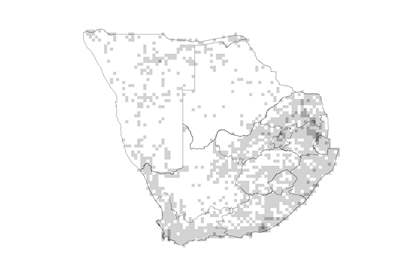 Species distribution and density. Darker squares represent higher density of members of this family. |
Introduction
Wild currant family
A family of mainly trees and shrubs, rarely herbaceous climbers or lianas, all species with resin channels and clear resinous sap that becomes dark on drying.
Distribution
This is a family mainly of tropical and subtropical areas. It has diversified in Central America, Central Africa, Madagascar, Indochina and Malaysia. Species are also found in the Mediterranean, East Asia and America. In southern Africa the highest diversity is along the Eastern Cape and KwaZulu-Natal coasts and in the eastern parts of the northern provinces.
Number of genera in the world
ca. 60
Number of species in the world
ca. 600
Number of genera in the Flora of southern Africa region
14
Number of species in the Flora of southern Africa region
133
Well-known southern African genera
Harpephyllum, Heeria, Lannea, Laurophyllus, Loxostylis, Ozoroa, Sclerocarya, Searsia
Growth forms
Mainly trees and shrubs, sometimes also climbers.
Habitats
Dry habitats and desert conditions to coastal scrub, grassland, woodland and forest.
Flagship species
Sclerocarya birrea (marula; maroela [A]; morula [NS]) is a tree with pleasant, edible fruit. Parts of the plant are used as medicine for the treatment of diarrhoea, dysentery, gonorrhoea, rheumatism and as a prophylactic against malaria. Household utensils are made from the wood and the trunks are carved into boats. The fibrous layers of bark are used as string and ropes. Trees are planted near orchards to attract pollinators. Fruit are used for jams and jellies, and the seeds are dried and eaten.
Significance of the family
Members of this family are used in the leather industry for their tannins. Important fruit include the mango and Jamaica plum, and nuts (cashew, pistachio). Fruit of the Brazilian pepper tree (*Schinus terebinthifolius) is used in cooking and the pepper tree (*S. molle) is widely cultivated as a garden ornamental for shade. Some trees are important in the timber industry (e.g. *Astronium, *Myracrodruon and *Schinopsis species). Exudates from some species may cause violent allergic reactions.
Diagnostic characters
Woody plants with resin channels especially in the bark and fruit. Leaves alternate; simple, pinnately compound or 3-foliolate; without bracts. Flowers small, green or yellow to white, usually with disc; unisexual but with sterile parts of other sex. Corolla 5, free . Anthers 5 or 10, free. Ovary superior, 1-locular with 1 seed. Styles 1-3, usually spaced widely apart (here visible on fruit). Fruit often a sideways flattened drupe . (Photos: JF; & : GN).
Did you know?
Marulas are used as flavourant in Amarula liqueur, and the fruits are rich in vitamin C.